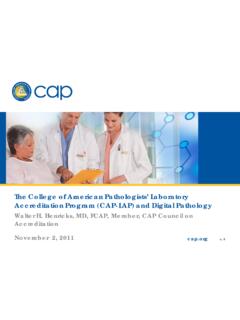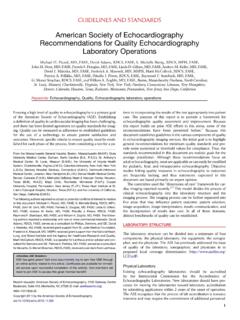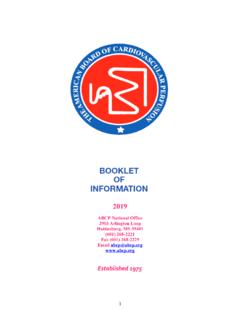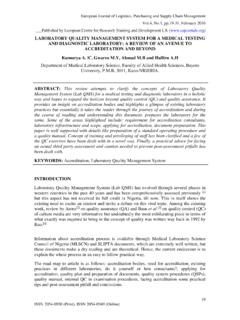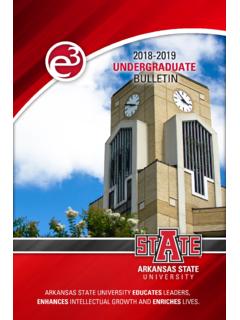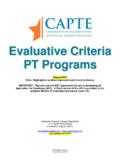Transcription of Laboratory Quality Management: A Roadmap
1 Laboratory Quality Management: A RoadmapLucia M. Berte, MA, MT(ASCP)SBB, DLM,CQA(ASQ)CQM/OELaboratories Made Better!, PO Box 670, Broomfield, CO 80038 0670, USA Total Quality management is a journey, not a destination. Thomas Berry[1]How do you view activities related to Laboratory Quality management ?Do you perceive these activities as being of special value in your everydaylaboratory life? Do you perceive these activities as additional, often burden-some work that is necessary only because it is required by regulatory andaccreditation organizations?Unfortunately, the latter misperception is still prevalent a full 18 yearsafter the College of American Pathologists first introduced Q-PROBES toacquire national Laboratory performance data on selected Quality perfor-mance measurements[2]. It seems that a large segment of the medical labo-ratory community has yet to understand that Quality must be built into, notinspected into, work processes to ensure Quality and patient safety[3].
2 Manylaboratories miss out by focusing on their destination (ie, passing an accred-itation inspection) instead of more carefully mapping out and enjoying any journey begins with a single step, then the journey toward totalquality management must begin with an understanding of the relationshipbetween medical Laboratory Quality activities that should be designed andsupported by Laboratory management and the technical activities that pro-duce Laboratory results for patient care. Fortunately, this dual relationshipis very simple, can be described graphically, and can become the fundamen-tal basis for Quality management and Quality improvement in any medicallaboratory of any size, scope, or specialty anywhere in the has taken a while for the dual managerial relationship between medicallaboratory Quality management activities and technical work to becomeE-mail - see front matter 2007 Elsevier Inc.
3 All rights Lab Med 27 (2007) 771 790comprehensively mapped out. It began in the United States in 1992, whenthe Food and Drug Administration (FDA) convened a public workshopto solve the Quality problems inherent in dealing with the HIV-AIDS viruscontaminating the nation s blood supply. The FDA s concern spurred bloodbank laboratories first to take notice of the dual Quality management activ-ities/technical procedural activities FDA workshop ultimately produced a guidance document for bloodbank Quality assurance[4]designed to complement FDA good manufactur-ing practice requirements[5,6]. The American Association of Blood Banksresponded to the FDA guidance with publication ofThe Quality Program[7]. It was in this program that the relationship between the Quality manage-ment activities mandated by the FDA in good manufacturing practicerequirements and the blood bank technical activities was first conceptual-ized, personnel working in hospital-based transfusion servicessoon realized that the relationship between Quality management and labora-tory technical activities extended far beyond the transfusion service to allother specialty disciplines in clinical and anatomic pathology 1999, an NCCLS1subcommittee, representing Laboratory , industry, andgovernment perspectives, produced the first medical Laboratory -specific qua-lity management system (QMS) model[8].
4 They based this salient model onthe regulations, accreditation requirements, and Laboratory standards thatexisted at that time. In 2004, the CLSI published the most recent update totheir QMS model[9,10]with a new edition scheduled for to the CLSIs synthesis of Laboratory Quality management activ-ities in the late 1990s, a group of international representatives from labora-tory accrediting organizations, academia, and public and privatelaboratories also began transforming an already extent international stan-dard for nonmedical industrial laboratories[11]for use in the medical lab-oratory environment. The initial result was the international medicallaboratory standardISO 15189, Medical laboratoriesdParticular require-ments for Quality and competence[12]. This international standard, first pub-lished in 2003, calls for medical laboratories worldwide to implement a QMSthat provides the level of Laboratory Quality and performance deemed nec-essary for ensuring minimally acceptable patient care and safety.
5 This stan-dard addresses, in detail, the elements of both Quality management andlaboratory technical activities necessary for reaching this overall goal. Sev-eral countries have adopted this document as their national standard andhave developed Laboratory accreditation programs based on therequirements in the standard (Canada is one example)[13].1In 2005, the NCCLS was renamed the Clinical and Laboratory Standards Institute(CLSI). The abbreviation, CLSI, is used throughout the rest of this in the United States are subject to so many national, state,and local requirements that it has been extremely difficult and time consum-ing to track compliance with every individual organization s listed require-ments. Fortunately, the CLSI QMS model provides a means for aggregatingall like requirements from different regulatory, accreditation, and standards-setting organizations into an easily understandable matrix.
6 This helpfulframework allows laboratories to develop Quality and technical policies,processes, and procedures that meet all current regulatory return for the effort, these documents describe the Laboratory s the modular framework and using it to implement the activ-ities necessary to meet requirements is the Laboratory s best and easiestmeans to build Quality into its daily work in the interests of patientcare and remainder of this article discusses the individual elements of theQMS model and how laboratories can use the model to build a QMS thatcovers all regulatory and accreditation requirements, prepares laboratoriesfor unannounced inspections, and provides the means for the laboratoryto make its best contribution to patient care and simple model for a Laboratory Quality systemMedical Laboratory work is composed of the technical activities that pro-duce Laboratory results for patient care and the management activities thatsupport the technical work.
7 It is the job of the Laboratory technical staff toperform preanalytic activities (blood sample collection, receiving, accession-ing); analytic activities (testing, examinations, interpretation); and postana-lytic activities (reporting results, archiving samples, charge capture) thattransform a clinician s order for a Laboratory test or examination into theresults used by the clinician to diagnose and treat , it is the job of the Laboratory supervisory and managerial staffto design and implement the supportive infrastructure that is necessary forthe technical work to proceed unimpeded. An integrated coordinationbetween technical and managerial activities is essential for the continuous,unimpeded realization of high- Quality , error-free, efficient, and effective lab-oratory 1depicts this important relationship between tech-nical and managerial activities.
8 Importantly, this figure also representsa QMS model that can be used in the medical Laboratory Quality system essentials (QSEs), first introduced by the AmericanAssociation of Blood Banks[14]and later adopted by the NCCLS-CLSI[8],are fundamental, generic management infrastructure elements that supportthe Laboratory s technical work. Each QSE consists of a collection of essen-tial information that characterizes a major managerial activity. Each QSEneeds to function properly for the Laboratory s technical work to be per-formed Quality MANAGEMENTThe information gathered for each of the 12 QSEs stems directly fromregulatory, accreditation, and standards requirements for laboratories andblood banks. The composition of each QSE was first prepared by sortingall the then-current (circa 1997) requirements into their respective QSEtopic.
9 Each item of the following was assigned to the most appropriate QSE: Clinical Laboratory Improvement Amendments of 1988 FDA good manufacturing practice regulations Joint Commission Laboratory standards College of American Pathologists inspection checklists American Association of Blood Banks standards Commission on Office Laboratory Accreditation standardsThis compilation was published[15]and subsequently served as the basisfor the original NCCLS-CLSI guideline[8].CLSI regularly updates the QSEs by assigning each newly published reg-ulatory, accreditation, or standards requirement to its respective the contributory base, CLSI included in their most recent QSEpublication items that were not present in United States based requirementsbut had been published as requirements in the international medical labora-tory standard ISO 15,189:2003[9].
10 Accrediting organizations are slowlyadding items from the international standard to their guideline HS1-A2[9]presents the requirements-derived content ofeach of the 12 QSEs, and additional information about how to implementa QMS. CLSI guideline GP26-A3[10]presents the requirements-derivedcontent for the medical Laboratory s path of preanalytic, analytic, andQuality System Essentials (QSEs)Documents and RecordsOrganizationPersonnelEquipmentPur chasing and InventoryProcess ControlInformation ManagementOccurrence ManagementAssessment: External and InternalProcess ImprovementCustomer Service and SatisfactionFacilities and SafetyService s Path of Workflow (work operations)Pre-serviceServicePost-servic eFig. 1. A simple generic model for a Quality management system. (FromCLSI. CLSI approved guide-line HS1: a Quality system model for health care.)
